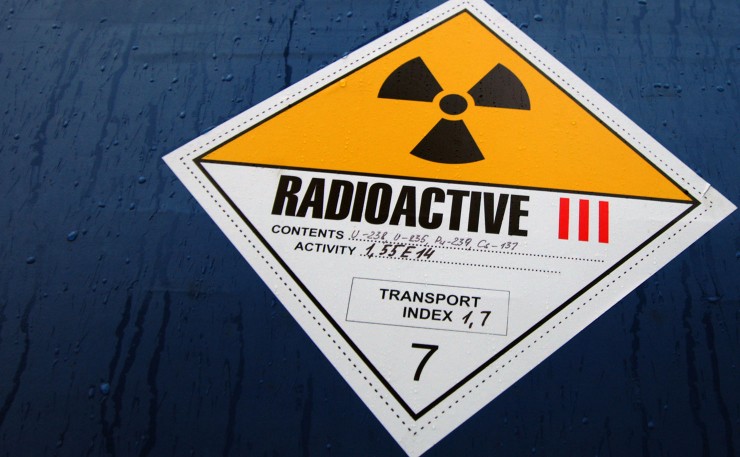Nuclear weapons and nuclear power are not the same thing. Even the much feared ‘dirty bomb’ is less of a challenge than many would have you think, writes Geoff Russell.
US President Barack Obama has been in the news recently at a nuclear security summit. You can read his opening speech here. The reduction in nuclear weapons around the world during the past 20 years has been a major but rarely noticed success. The deal was simple and relatively cheap.
The US paid Russia about US $13 billion for highly enriched uranium from the warheads of about 20,000 bombs. Like other elements, uranium comes in various forms with numeric tags: U-235, U-238 and so on. Natural uranium is a mixture with the U-235 form being just 0.7 per cent. The uranium in bombs is called highly enriched, which means it’s over 90 per cent U-235. The uranium in a normal reactor is about four per cent U-235 and is useless for bombs. Imagine if the only flour you could buy was a mixture of 99.3 percent common white flour and 0.7 per cent durum wheat flour. It would be no easy feat to take 130 bags and process them to get a single bag with 90 per cent durum wheat flour; enriching uranium is harder.
Un-enriching is somewhat easier, and the Russians took their weapons uranium, un-enriched it, and sent it to the US for use in nuclear reactors. In recent years, this has supplied about 12 per cent of the world’s reactor fuel. The US has also been reducing its own weapons material by diverting it to fuel aircraft carriers and submarines. These have always used highly enriched uranium as fuel because it lasts longer, meaning an aircraft carrier can go 10 years between refuelling. When the aircraft carrier USS Carl Vinson went to Haiti after the devastating 2010 earthquake, its nuclear reactor powered desalination plant produced large amounts of life saving clean water. Jesus may have turned water into wine, but Carl Vinson did one better by turning bomb material into water.
There is, however, considerable material which still needs to be dealt with and plenty of good will to get the job done.
But the Summit’s headline story has been about terrorism and dirty bombs, with many news services focusing on Obama’s claim that a madman could kill and injure hundreds of thousands of innocent people using an apple sized piece of plutonium. Given the considerable supply of madmen (and even a few mad women) on the planet, you could be forgiven for wondering why this has never happened during the past 60 years.
Hollywood and other makers of fantasy fiction would have you believe nuclear devices are easy to make, and even easier to steal. They’d have you believe that there is a thriving trade in dirty bombs all miraculously defused at the last minute by people cutting the right wire before a blinking LED counter hits zero!
So why do all the world’s terror groups stick with more modest explosives killing 10s or 100s of people?

For decades the anti-nuclear movement has worked assiduously to link bombs and terrorism with nuclear power reactors, so it’s worth spending a little time explaining why they’ve been wrong for decades. Some of what follows will also explain why nuclear terrorism is both unlikely and of far less concern than ordinary terrorism.
Let’s deal with ordinary bombs first.
They are made with weapons grade material, which is what the Summit was about. Either uranium or plutonium will do. There’s no weapons grade anything in a nuclear power plant. So there’s nothing to steal in the unlikely event that a terrorist had any idea of what to do with it if there was.
Some people assert that because plutonium is produced in a power reactor then you could steal that and make a bomb. This isn’t true. As reactor fuel burns (fissions), you get a variety of elements formed, including plutonium-239, which is indeed good for bombs. But you also get plutonium-240 and others which make any bomb fizzle rather than bang. It’s worth explaining this in detail so you can understand how big this particular anti-nuke deception has been. You need 93 per cent Pu-239 to make a bomb. But as the reactor runs, more and more Pu-240 (and other impurities) are produced, these contaminate fuel and make any Pu-239 useless. Theoretically, if you go to a reactor within a month of it being refuelled, then there’s some Pu-239 in the fuel and not too many impurities.
Assuming you get into the reactor, who’s going to unload the core for you?
Normally, when a reactor is shut down for refuelling, the fuel is taken from the core to a spent fuel pool, a third to a half of the fuel is removed and replaced with fresh fuel. Then it’s put back into the core. This process sounds simple but typically involves a thousand or so extra contractors on site and takes a month.
Who’s going to unload one or more fuel assemblies for you? Who’s going to tell you which ones are fresh? How will you load your 300-600 kilogram fuel assembly onto a truck? They are hot in every sense of the word. Quite deadly both because of their temperature and radioactivity. It’s far worse than robbing a blast furnace of its molten iron. And remember, you have to get it done quickly before the cavalry arrive.
But what about a rogue Government? Certainly, they might just employ a thousand people every couple of months to unload a reactor, unload some fuel, find a re-processer to separate the plutonium, put it all back again and run the reactor for another month and so on. But anybody dumb enough to build a bomb that way wouldn’t be smart enough to design one in the first place. If you want Pu-239, you build a small reactor specially designed for the task and tuck it away somewhere off-grid. This costs a tiny fraction of the price and is faster. And if you want to make a uranium bomb, then you do what the Iranians did and build an enrichment facility; again, a power reactor is useless.
In summary, using a multi billion dollar power reactor to make bomb material is like using a jumbo jet to move between your kitchen and bathroom. The propaganda linking of the nuclear power industry with the bomb industry is a tale of astonishing audacity.
So there’s nothing in a power reactor which a terrorist would want to steal if they wanted to build an ordinary bomb.
But what about a dirty bomb? These little gizmos have saved many a film maker bereft of anything resembling a real plot. The world produces six million tonnes of barium, and a gram of barium in the form of barium carbonate can kill you; that might make a plot, but it’s got a new word in it. It’s far easier to base a script around an established buzz word than to infect a new one with appropriate levels of fear. Obama took advantage of this. He didn’t have to explain his plutonium scenario; the mere mention was enough to key into long established mythology.
Writing in 1990, US Professor of Physics Bernard Cohen calculated that you could cause about two million cancers with a carefully inhaled half kilogram of plutonium. That might be where Obama’s speech writer got his or her information. But Obama didn’t tell you the process. What would you physically need to do?
At the risk of tutoring terrorists in the fine arts of killing, here’s the nitty gritty behind the process. First transform the plutonium into plutonium oxide (google that for homework), then crush it and suspend the finely ground plutonium in saline and find a way to spray it up the noses of many millions of people; not just two. A decade or two later you’ll get your cancers.
Terrorism 101 says bloody broken bodies are rather more effective than a process with an impact more akin to an increase in smoking rates. For all anybody knows there may have already been any number of dirty bomb attacks already, it’s just that nobody noticed. The terrorists may have expected people to fall over writhing in agony and when that didn’t happen they were too embarrassed to deliver the press release.
The fear of cancer well into the future doesn’t seem to bother smokers or people eating beef or bacon, so it’s unlikely to be an effective weapon of terror. But the assumptions behind the calculation are also clearly ridiculous. People will not line up to have a measured dose of plutonium oxide injected into their noses; nor can a bomb do anything like this. Cohen understood this and went on to calculate what he thought was a far more realistic outcome for a dirty bomb made with a half a kilogram of plutonium.
Here’s what Cohen found using more realistic assumptions:
In summary, a pound of plutonium dispersed in a large city in the most effective way would cause an average of 19 deaths [after a decade or more]due to inhaling from the dust cloud during the first hour or so, with seven additional deaths due to resuspension during the first year, and perhaps one more death over the remaining tens of thousands of years it remains in the top layers of soil. This gives and ultimate total of 27 eventual fatalities per pound of plutonium dispersed.
For decades the anti-nuclear movement has been doing what Obama’s speech writer did and taking snippets out of context and using them to fool and frighten people.
The mechanism for generating fear with nuclear fantasies has much in common with a horror film; the scariest monster is the one you can’t see. We are depressingly used to car bombs and barrel bombs and suicide bombers and machetes and dysfunctional societies with automatic weapons. We have a rational, reasonable and very well informed fear of them. But our fear of dirty bombs is based in stories woven from bizarre assumptions. And because these bombs only exist in our imaginations, people can say what they like about them.
The fantastic conflation of nuclear power with terrorism, weapons and dirty bombs have done the fossil fuel industries a great service for many decades, but it’s time we realised that nuclear power is far harder to bend to nefarious purposes than more mundane industries like steel, chemicals, communications and fertilisers. It’s time we also realised that prodigious carbon free energy is one of the two planks needed for an environmentally benign climate friendly lifestyle that can also reduce the poverty and inequities that help fuel terrorism. The other plank of course is a compassionate climate friendly diet.
Donate To New Matilda
New Matilda is a small, independent media outlet. We survive through reader contributions, and never losing a lawsuit. If you got something from this article, giving something back helps us to continue speaking truth to power. Every little bit counts.





